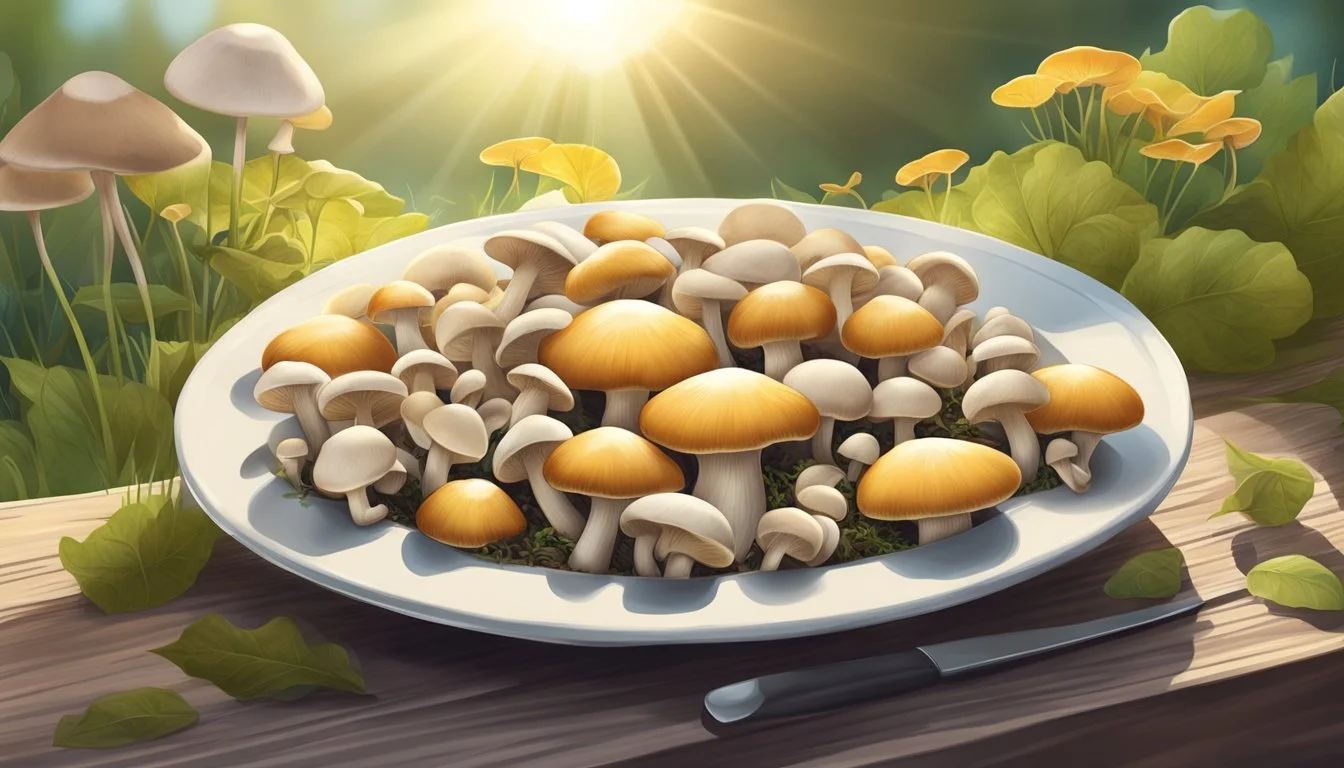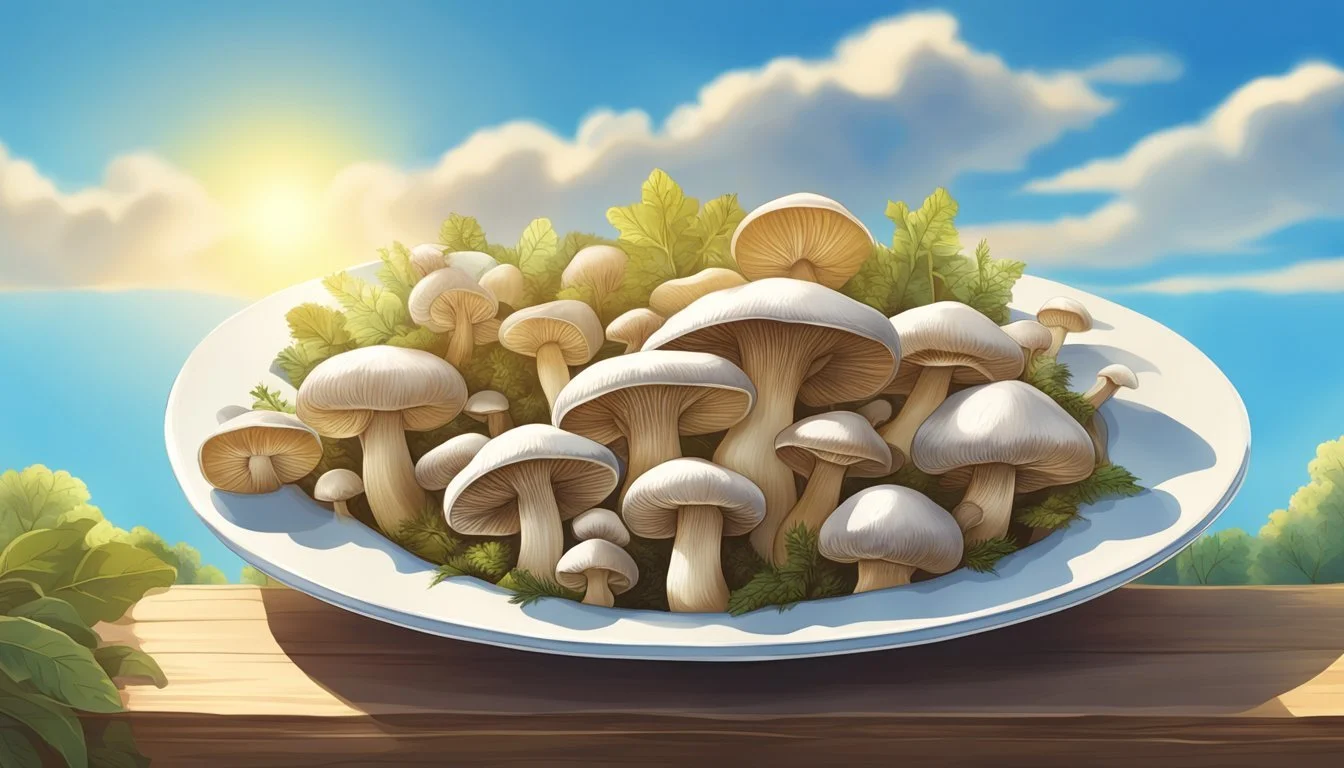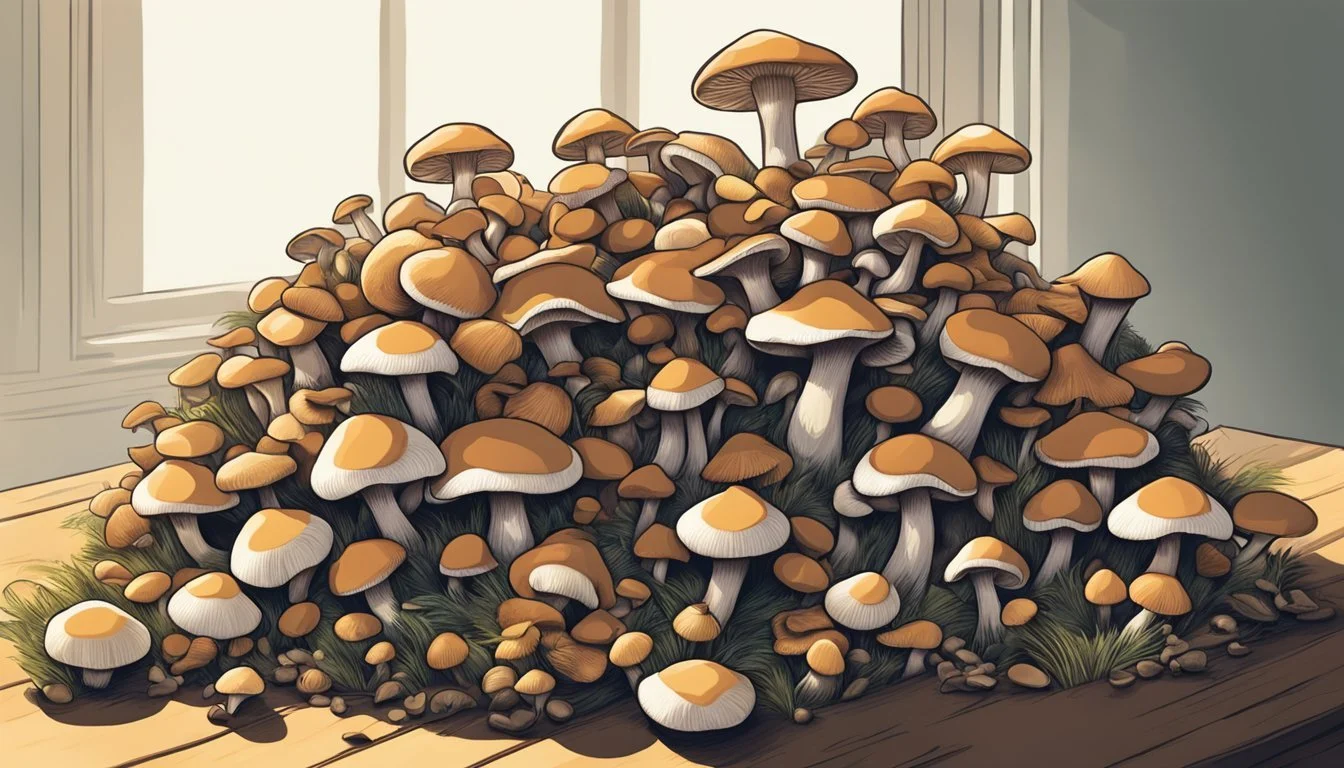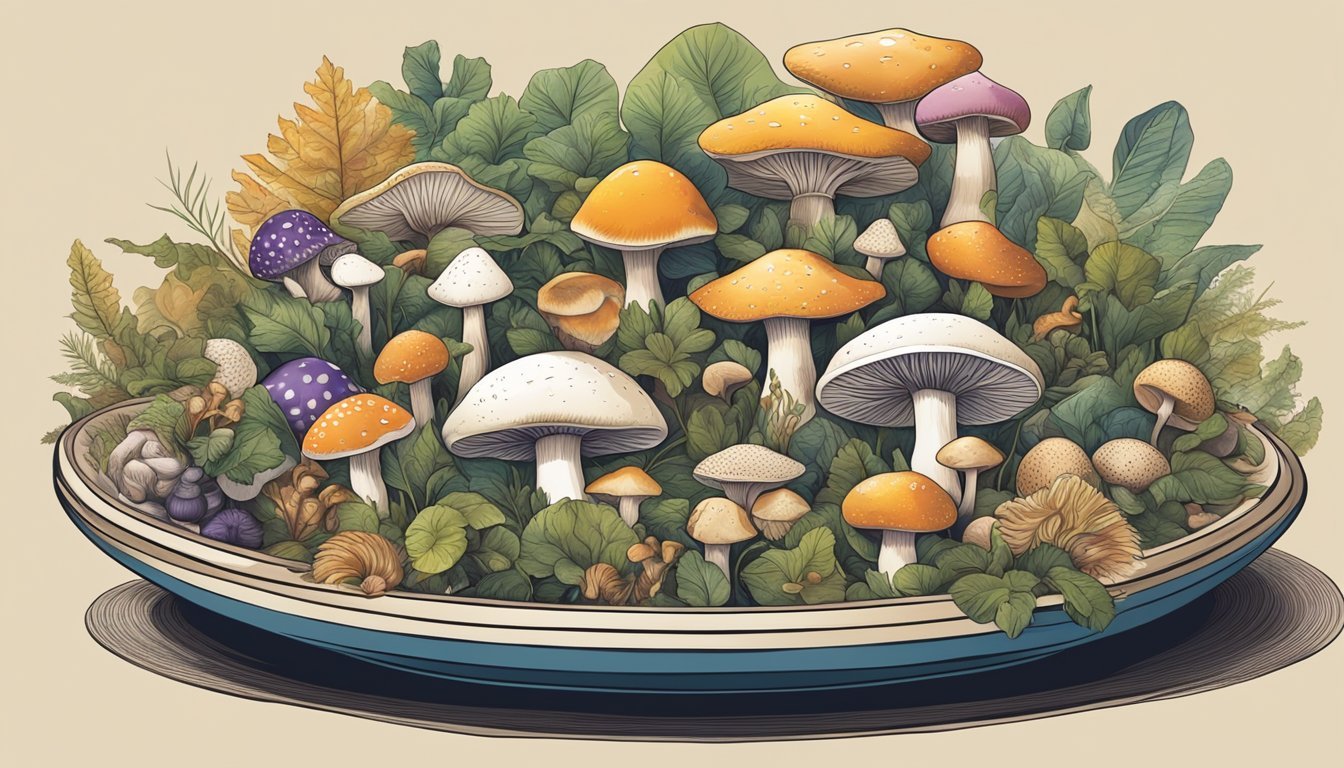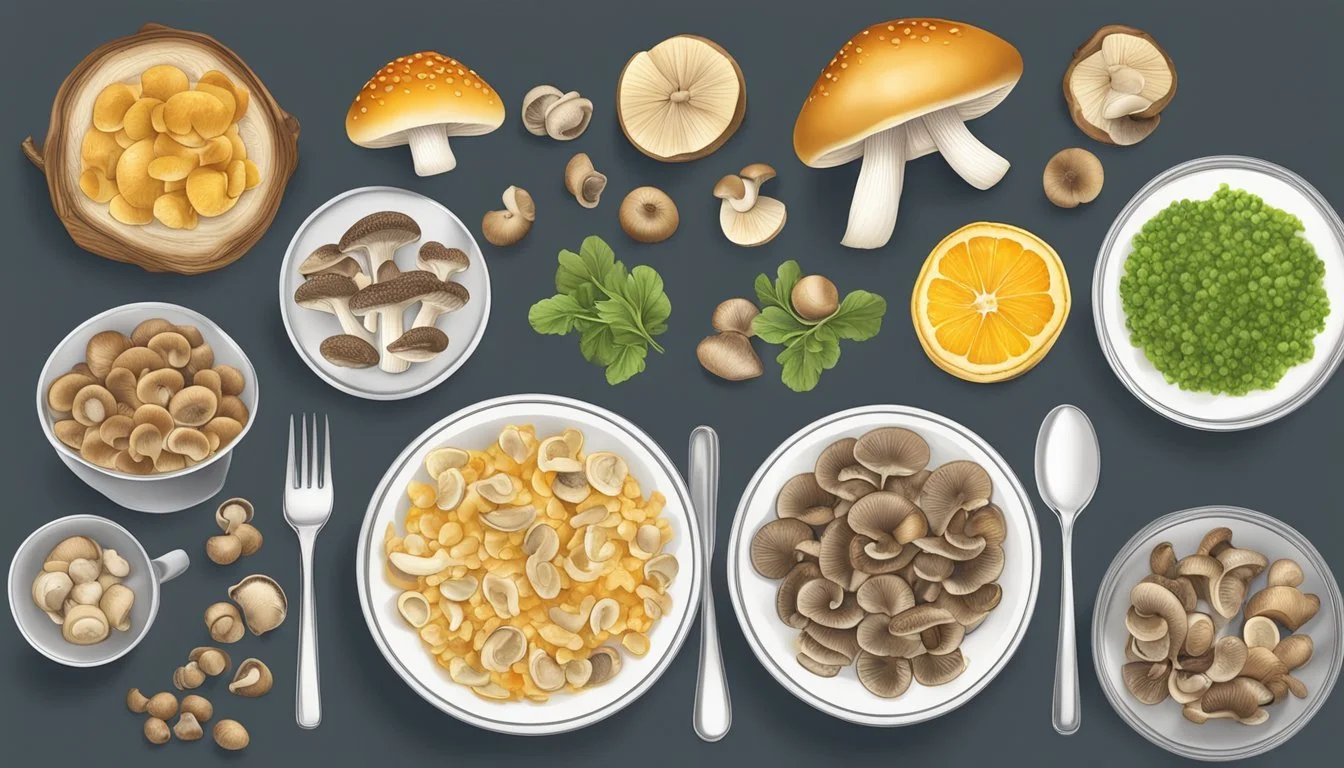How Many Servings of Mushrooms to Optimize Vitamin D Intake
Mushrooms (What wine goes well with mushrooms?) stand out as a unique source of vitamin D among plant-based foods, a nutrient typically sourced from sun exposure or animal-derived foods like oily fish. Unlike most produce, mushrooms have the ability to synthesize vitamin D upon exposure to ultraviolet (UV) light, much like the human body. The sun's midday rays can increase a mushroom's vitamin D content, making them a valuable contributor to daily dietary requirements.
Incorporating mushrooms into one's diet can significantly impact vitamin D intake, especially for those following plant-based diets or with limited sun exposure. Servings of mushrooms, particularly if they have been exposed to UV light, provide a variable amount of vitamin D. Fresh, UV-exposed button mushrooms, for instance, can deliver the recommended daily amount of vitamin D in a 100g serving after just 15-20 minutes in the sun.
While mushrooms naturally contain some vitamin D, levels can be too low to meet daily needs without additional UV light exposure. The amount of vitamin D in mushrooms also varies based on the type and how they are grown and processed. Carefully selecting mushrooms grown under UV light and checking nutritional content can ensure one reaps the maximum vitamin D benefits from these versatile fungi.
The Importance of Vitamin D
Vitamin D plays a crucial role in maintaining bone health by facilitating calcium absorption in the bones. Adequate levels of this nutrient are essential to prevent bone diseases such as rickets in children and osteoporosis in adults. Individuals with sufficient vitamin D levels benefit from stronger bones and a lower risk of fractures.
The immune system also greatly relies on vitamin D. This nutrient is known to modulate the immune response, acting as a protective agent against infections. Research has associated adequate vitamin D levels with a reduction in the likelihood of developing autoimmune diseases.
Beyond bones and immunity, vitamin D is linked to various aspects of general health. Epidemiological studies suggest a correlation between optimal levels of vitamin D and lower incidences of certain cancers, though more research is necessary to establish a direct causal relationship.
Disease Association with Vitamin D Cardiovascular Disease May help reduce risk Diabetes Beneficial for glucose metabolism
Deficiency in vitamin D is associated with deficiency conditions such as rickets and osteomalacia. Apart from its well-known functions, vitamin D deficiency is emerging as a potential factor in the development of cardiovascular diseases and diabetes, where it may play a role in glucose metabolism. Ensuring an adequate intake of vitamin D is crucial for overall health and can be addressed by dietary sources, supplements, and responsible sun exposure.
Mushrooms as a Source of Vitamin D
Mushrooms can provide a unique plant-based source of vitamin D, particularly when they are exposed to ultraviolet (UV) light. These fungi synthesize vitamin D2, and to a lesser extent D3 and D4, making them a valuable food item for those seeking non-animal sources of this nutrient.
Varieties Rich in Vitamin D
Certain varieties of mushrooms are especially good at accumulating vitamin D. Wild mushrooms such as chanterelles (Cantharellus cibarius) and morels (Morchella spp.) are naturally high in vitamin D, sometimes containing up to 1200 International Units (IU) per 3.5-ounce serving. Among cultivated mushrooms, shiitake (Lentinula edodes), oyster (Pleurotus ostreatus), and UV-exposed button mushrooms (Agaricus bisporus) are notable for their higher vitamin D content.
Factors Affecting Vitamin D Content
The vitamin D content in mushrooms can vary significantly based on several factors:
Exposure to UV Light: When mushrooms are exposed to sunlight or artificial UV light, their ergosterol content converts to vitamin D2. The duration and intensity of this exposure are key determinants of their vitamin D levels.
Storage: Vitamin D levels can decrease over time; hence, proper storage is crucial. Some studies suggest that prolonged boiling or frying may lead to a reduction in vitamin D content by up to 40%.
Cooking: It is advisable to minimize the cooking time for mushrooms to preserve their vitamin D levels. For example, frying mushrooms without oil for just 5 minutes can reduce their vitamin D content by 15%.
Comparison with Other Food Sources
When compared to other food sources, UV-exposed mushrooms are a standout option for vegans and vegetarians due to their plant origin. Most non-fortified food sources of vitamin D are animal-based, such as fish, liver, and egg yolks, which contain vitamin D3. In contrast, the vitamin D found in mushrooms is primarily D2, with mushrooms exposed to UV irradiation offering substantial amounts of this bioavailable vitamin.
Recommended Servings and Dietary Intake
Mushrooms can be a significant source of dietary vitamin D, particularly when exposed to sunlight, and contribute to the dietary intake of this nutrient. This section outlines the optimal serving sizes for healthy adults and adjustments for specific dietary needs to ensure adequate serum 25-hydroxyvitamin D levels.
Servings for Healthy Adults
For healthy adults, incorporating mushrooms into the diet can help meet the recommended dietary intake of vitamin D. While sunlight remains the primary source of vitamin D, mushrooms offer a dietary alternative, especially for those with limited sun exposure. Experts suggest that including 3.5 ounces (100 grams) of UV-exposed mushrooms could provide up to 10μg (400 IU) of vitamin D, contributing significantly to the daily recommended intake of 5-15μg (200-600 IU) for adults.
Bioavailability of vitamin D from mushrooms is similar to that from supplements. However, servings may vary depending on factors such as mushroom type, exposure to UV light, and individual absorption rates. Most dietary guidelines suggest aiming for a daily vitamin D intake that maintains serum 25-hydroxyvitamin D levels above 20ng/mL to ensure bone health and overall well-being.
Adjustments for Specific Needs
For individuals with specific dietary needs including those with vitamin D deficiencies, increased risk of osteoporosis, or limited sun exposure, the intake of vitamin D from mushrooms can be strategically augmented. A healthcare provider may recommend higher servings or the addition of a vitamin D supplement to achieve the desired serum 25-hydroxyvitamin D levels.
It is important to note that those with specific health conditions or dietary restrictions should seek individualized guidance to accurately adjust their dietary intake of vitamin D. For example, individuals who are obese may require more vitamin D due to lower bioavailability and different distribution of the nutrient in body fat tissues.
In summary, mushrooms can be an effective dietary source of vitamin D for most adults and, with the right adjustments, for those with particular dietary needs to support serum 25-hydroxyvitamin D levels for a range of health outcomes.
Benefits of Consuming Mushrooms
Mushrooms are a nutritional powerhouse, offering a range of benefits due to their unique composition. They are not only a source of vitamin D but also provide a variety of nutrients that contribute to overall health.
Nutritional Value Beyond Vitamin D
Mushrooms contain a spectrum of nutrients that surpass their value as a vitamin D source. Here's a breakdown of their nutritional content per one cup serving:
Selenium: An antioxidant that plays a critical role in DNA synthesis and protection from infection.
Potassium: Vital for maintaining normal heart rhythm, fluid balance, and muscle and nerve function.
Copper: Integral for producing red blood cells and maintaining healthy bones and nerves.
Fiber: Essential for digestive health.
Protein: An important component for the growth and repair of the body’s cells and tissues.
These nutrients, alongside a host of B vitamins, contribute to the overall nutrient density of mushrooms.
Role in Preventing Disease
The compounds found in mushrooms may contribute to disease prevention due to their:
Antioxidant properties, which help combat free radicals that can lead to cell damage and subsequent health issues.
Anti-inflammatory effects, which may reduce the risk of chronic diseases like heart disease and type 2 diabetes.
Additionally, the selenium in mushrooms contributes to a robust immune system.
Support for Vegan and Plant-Based Diets
Mushrooms are an excellent addition to vegan and plant-based diets due to their:
High-quality protein content, which is essential for people who do not consume animal products.
Fiber contributes to satiety and aids in maintaining a healthy digestive system.
Dense nutritional profile, providing essential minerals such as zinc, copper, and especially vitamin D in diets that commonly lack these nutrients.
Their meaty texture also makes them a popular meat substitute, enhancing meals both nutritionally and gastronomically.
Incorporating Mushrooms into the Diet
Mushrooms are a versatile ingredient that can be included in a variety of dishes to increase vitamin D intake. They are available in many species, each offering a unique flavor and nutrient profile.
Simple Dietary Additions
Incorporating mushrooms into one's diet can be as straightforward as adding them to existing meals. Salads and pastas are two dish types greatly enhanced both nutritionally and tastefully by mushrooms. A simple addition of mushrooms like cremini, porcini, or white button mushrooms can elevate the umami flavor of a dish.
For salads, one might consider:
Sliced raw white button mushrooms for a classic touch.
Grilled portobello slices for a meaty texture.
Sautéed cremini mushrooms for a deeper flavor.
When cooking, mushrooms can be integrated into pasta sauces or as a topping for pizzas. The mushrooms should be cleaned and sliced, then cooked to preference. Different cooking methods, such as grilling or sautéing, can unlock various flavor profiles from the mushrooms.
Recipe Ideas
Mushrooms can star in many recipes, transforming a simple dish into a gourmet experience. Their ability to infuse dishes with an umami-rich flavor makes them especially valuable in numerous cuisines.
For example:
Pasta: Sauté shiitake mushrooms and blend into creamy sauces.
Risotto: Mix arborio rice with sautéed porcini mushrooms and white wine for a classic risotto.
Cooking with gourmet mushrooms, specifically, can add not only taste but also a hearty dose of nutrients to any meal. When mushrooms are exposed to UV-light, they can provide a substantial amount of vitamin D, essential for health. It's simple to start including varieties like lion’s mane, maitake, shiitake, and oyster mushrooms to enhance both the flavor and nutritional content of everyday meals.
Potential Risks and Considerations
While mushrooms can be a beneficial source of vitamin D, it is important to consider potential risks and dietary concerns. Individuals should be mindful of allergies, digestive issues, the risk of consuming toxic varieties, and the potential for contaminants.
Allergies and Digestive Concerns
Individuals with known allergies to fungi should avoid mushrooms, as they can cause serious allergic reactions. For others, mushrooms can sometimes lead to digestive issues due to their complex carbohydrates that might be difficult to digest. Incorporation of mushrooms into one's diet should be done gradually, especially for those with sensitive stomachs.
Toxic Varieties and Contaminants
Consuming wild mushrooms poses the risk of ingesting toxic varieties, which can lead to symptoms such as nausea, vomiting, and more severe health complications. It is crucial to consume mushrooms that are certified safe for intake. Mushrooms can also accumulate contaminants from their growing environment, including bacteria and potentially harmful levels of sodium if grown in high-salt conditions. Choosing mushrooms from reputable sources minimizes this risk. Additionally, reliance on supplements instead of natural food sources for vitamin D should be approached cautiously, as excess intake can lead to toxicity.
The Science of Vitamin D in Mushrooms
Mushrooms have emerged as a unique source of vitamin D, particularly vitamin D2, which they can synthesize when exposed to ultraviolet (UV) light. Their fortification potential makes them a valuable dietary component, especially for those seeking plant-based sources of this vital nutrient.
Synthesis and Fortification Processes
When mushrooms are exposed to UV light, either from sunlight or artificial sources, they synthesize vitamin D2 (ergocalciferol) through a process similar to how human skin produces vitamin D3. Ergosterol, the precursor found in mushrooms, converts to vitamin D2 when exposed to UV radiation. Some mushrooms are naturally high in ergosterol, which leads to higher vitamin D2 levels upon UV exposure.
Fortification of mushrooms is achieved by artificially exposing commercially grown mushrooms to UV light. This significantly enhances their vitamin D2 content. Advances in food technology allow for precise control of the fortification process, resulting in mushrooms with consistent levels of vitamin D.
Effect of UV Light Exposure
UV light exposure plays a critical role in boosting the vitamin D content in mushrooms. Studies show that:
Just 5 minutes of UV light exposure can increase the vitamin D levels in mushrooms dramatically.
The vitamin D content can increase by over 800% after this brief period of UV radiation.
It is important to note that the levels of vitamin D2 can decrease with storage and cooking, and are highest when mushrooms are fresh and minimally processed. Different mushroom varieties, such as shiitake and oyster mushrooms, show impressive increases in vitamin D2 after UV exposure, indicating a species-dependent response to UV light.
It's worth mentioning that while vitamin D3 is predominantly found in animal products, certain mushroom species can also produce vitamin D3 and D4 upon exposure to ultraviolet light, though in smaller quantities compared to D2. Therefore, UV-exposed mushrooms can be a versatile addition to the diet, contributing to the overall vitamin D intake.
Cultural and Geographic Considerations
Cultural heritage and geographic location play significant roles in the consumption patterns of mushrooms and the utilization of these fungi as a source of vitamin D.
Traditions in Mushroom Consumption
In Europe, the tradition of foraging for mushrooms is deeply ingrained, with chanterelle and oyster mushrooms being among the popular varieties sought after in the wild. Shiitake mushrooms, on the other hand, have been a staple in Asian cuisines and are now gaining popularity in North American diets due to their flavor and nutritional benefits. The subtle, yet delicate flavor of enoki mushrooms makes them a favored ingredient in many Asian dishes. In contrast, cremini mushrooms, also known as baby bellas, are extensively consumed in the United States and are recognized for their versatility in recipes.
Vitamin D and Mushrooms Around the World
Mushrooms' vitamin D content varies by type and region. Wild mushrooms in North America, like those found in the United States, often have higher vitamin D levels due to natural sunlight exposure. Conversely, commercial cultivation typically occurs in dark environments, leading to lower vitamin D content. However, innovative production methods, such as exposing mushrooms to ultraviolet light, have been adopted to enhance vitamin D levels. This technique has been utilized with varieties such as shiitake and cremini mushrooms to meet dietary recommendations more effectively.
Conclusion
Mushrooms are a unique dietary source of vitamin D, particularly vitamin D2, which is less common in the diet compared to vitamin D3. They can synthesize this nutrient when exposed to ultraviolet light, just as human skin does. Therefore, they serve as a plant-based option for individuals seeking to improve their vitamin D intake.
In terms of servings, practical guidance suggests that incorporating mushrooms into daily diets could contribute to the required vitamin D levels, particularly if they have been exposed to sunlight. Consider the factors of UV exposure and drying processes, as these impact the vitamin D content of mushrooms.
The health benefits of adequate vitamin D intake are substantial. It supports bone health by preventing osteomalacia, contributes to neurological function possibly lowering the risk of neurodegenerative diseases, such as Alzheimer’s, and can influence gut health and blood pressure regulation. Regular consumption of vitamin D-rich mushrooms could be beneficial in these areas.
It's important to remember that while mushrooms can contribute to vitamin D levels, diversity in sources ensures a more balanced intake of nutrients. Also, individuals should consider consulting with a healthcare provider to determine the appropriate amount of mushroom servings and dietary vitamin D necessary for their specific health status.
Factors to Consider Impact on Vitamin D Intake Mushroom type (e.g., button mushrooms) Varies by mushroom species Sunlight exposure of mushrooms Increases vitamin D2 levels Serving size Dependent on individual dietary needs Combination with other vitamin D sources Ensures balanced nutrient intake
Consume mushrooms as part of a varied diet, and consider sunlight exposure when aiming to enhance their vitamin D content.

